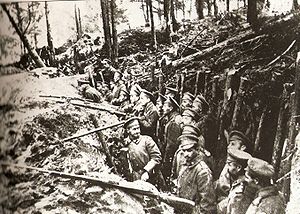Battle of Sarikamish
| Battle of Sarikamish Сражение при Сарыкамыше-Srazhenie pri Sarykamyshe Sarıkamış Muharebesi |
|||||||
|---|---|---|---|---|---|---|---|
| Part of Caucasus Campaign of Middle Eastern theatre in World War I | |||||||
 Russian trenches in the forests of Sarikamish. |
|||||||
|
|||||||
| Belligerents | |||||||
|
Armenian volunteers |
|
||||||
| Commanders and leaders | |||||||
|
Arshak Gafavian Hamazasp Srvandztyan |
|
||||||
| Units involved | |||||||
| Russian Caucasus Army | 3rd Army | ||||||
| Strength | |||||||
| 60,000 | 118,660 218 artillery pieces |
||||||
| Casualties and losses | |||||||
| 16,000 killed and wounded 12,000 sick |
23,000 killed 10,000 died in hospitals 10,000 wounded 7,000 captured |
||||||
The Battle of Sarikamish (Armenian: Սարիղամիշի ճակատամարտ (Sarighamishi chakatamart), Russian: Сражение при Сарыкамыше; Turkish: Sarıkamış Harekatı) was an engagement between the Russian and Ottoman empires during World War I. It took place from December 22, 1914 to January 17, 1915 as part of the Caucasus Campaign.
The outcome was a Russian victory. The Ottomans employed a strategy which demanded that their troops be highly mobile and to arrive at specified objectives at precise times. This approach was based both on German and Napoleonic tactics. The Ottoman troops, ill-prepared for winter conditions, suffered major casualties in the Allahuekber Mountains.
Afterward, Ottoman leader Enver Pasha publicly blamed his defeat on Armenians and the battle served as a prelude to the Armenian Genocide.
Russia viewed the Caucasus Front as secondary to the Eastern Front and the Eastern Front enjoyed the major share of Russian resources. Russia had taken the fortress of Kars from the Turks during the Russo-Turkish War in 1877, when it was incorporated into the militarily administered Kars Oblast, and it now feared a Caucasus Campaign aimed at retaking Kars and the port of Batum. A Caucasus Campaign would have a distracting effect on Russian forces. The plan found sympathy with German advisors in that a success in this region would mean a diversion of Russian forces to this front from the Polish and Galician fronts. Germany supplied resources and the Ottoman Third Army was used in the battle. The immediate strategic goal of the Caucasus Campaign was to retake Artvin, Ardahan, Kars, and the port of Batum. As a longer term goal, head of the Ottoman war ministry İsmail Enver hoped a success would facilitate opening the route to Tbilisi and beyond, initiating a revolt of Caucasian Muslims. Another Turkish—or rather German—strategic goal was to cut Russian access to its hydrocarbon resources around the Caspian Sea.
...
Wikipedia
